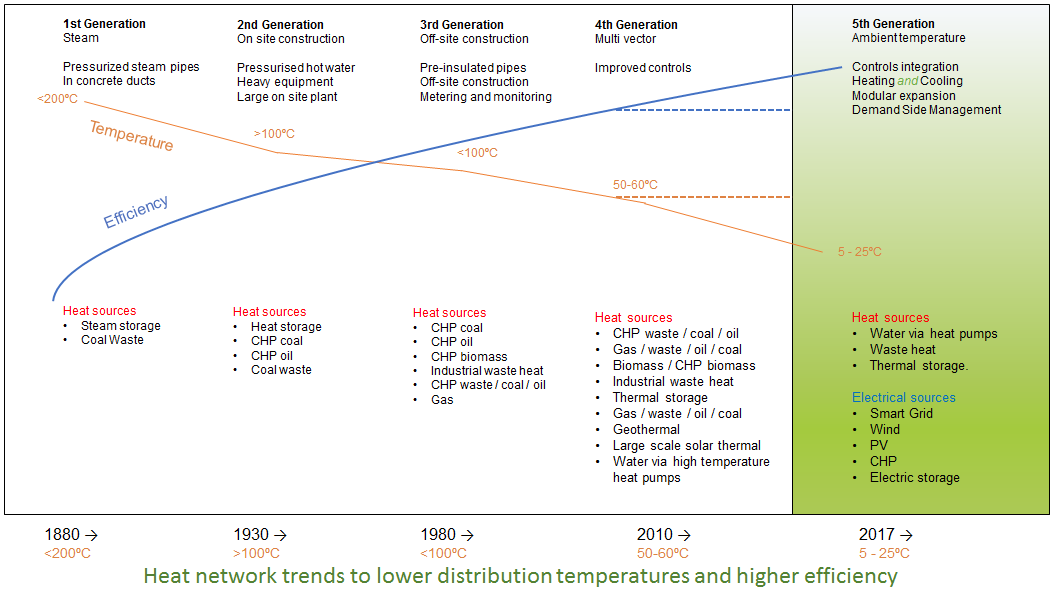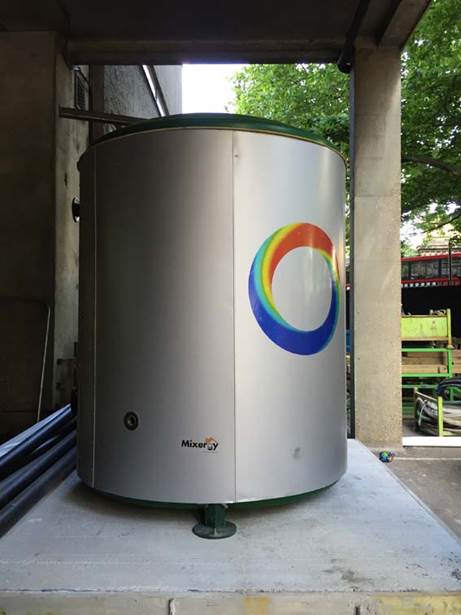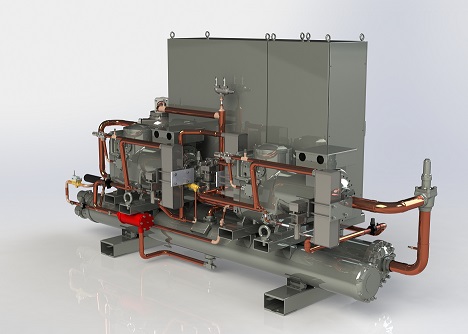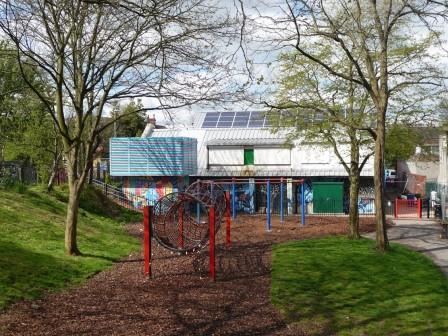Fifth Generation District Heating & Cooling Networks
The key elements of a fifth generation district heating and cooling network include:
- ground temperature heat distribution circuit – (no need for expensive insulation)
- heating & cooling – (provided by a heat pump in each building)
- demand side response – (to reduce cost of electricity and reduce carbon emissions at peak times)
- thermal energy storage – (to extend the benefits of using Demand Side Response)
- integration of waste heat opportunities – (from any building that rejects heat above ambient ground temperature)
- flexibility to expand (or contract) the network to meet changes in demand

Trend towards lower temperature heat distribution
The first generation of district heating networks started in New York in the 1880s with heat distribution by pressurised steam at over 100°C.
The second generation from the 1930s was based on pressurised hot water with temperatures above 100°C.
The third generation from the 1970s was also based on hot water, but with temperatures below 100°C and usually incorporated prefabricated parts in construction. Many suffered from poor temperature control systems which led to wasted heat.
The fourth generation has been based on reduced temperature water distribution at around 60°C to limit installation costs and heat losses to the ground, together with a higher contribution from renewable energy and waste heat in order to limit carbon emissions and reduce air pollution. It has also been characterised by more sophisticated controls.
The trend to lower distribution temperatures reaches its logical conclusion with fifth generation networks with distribution of water at close to ambient ground temperature. They employ distributed heat pumps: a heat pump in each building to transfer heat in to achieve heating when buildings need heating, and to transfer heat out when buildings need cooling. Heat losses to the ground are eliminated and the cost of installing the distribution circuit is radically reduced.
Heating & Cooling: Heat Sharing Networks
Modern buildings built to higher insulation standards need less heating in the winter, but they do need cooling in summer – which has generally not been provided by CHP-based networks. It is much more efficient for cooling to be provided by heat pumps rejecting heat into an ambient ground temperature circuit, than by forcing roof mounted chillers to waste heat into hot air.
The by-product of heat rejection into the ambient ground temperature circuit is to increase its temperature: this is beneficial for those buildings that need heating.
The by-product of heat extraction from the ambient ground temperature circuit is to reduce its temperature: this is beneficial for those buildings that need cooling.
Demand Side Response
Basing heating on heat transfer by heat pumps using electricity not only eliminates local emissions, it also opens up the opportunity to benefit from Demand Side Response.
Those buildings which choose to shift the timing of their demand for electricity for heating (or for cooling) can earn income from the Grid by responding to changing electricity prices within each 24 hour cycle. This requires a sophisticated control system and a plan to balance the temperature of the thermal mass of the building to maintain comfortable internal temperatures to suit the occupants while earning income from the Grid.

Thermal Energy Storage
The capacity to earn revenue from Demand Side Response can be extended where electrification of heating and cooling is used in conjunction with insulated thermal energy storage in large water cylinders: heat can be stored when the price of electricity is low (as it often is at night) and used during the day when peak electricity prices would have applied.
Integration of waste heat opportunities
A low temperature circuit allows the opportunity to gather heat from any source of waste heat in the district. This includes surplus heat from industrial processes and surplus heat from cold stores and supermarkets. The low temperature circuit provides an efficient route to reject surplus heat to: the absorption of waste heat benefits all those buildings which need to absorb heat from the circuit. This results in a Heat Sharing Network with improved cooling for those who need cooling and improved heating for those who need heating.
The benefits of Fifth Generation District Heating and Cooling
The benefits of Fifth Generation District Heating and Cooling include:
- flexibility to scale up (or down)
- ability to provide cooling as well as heating (from one integrated system)
- ability to serve buildings of different eras
- zero carbon emission on site
- zero air pollution emissions on site
- ability to recycle waste heat
- economics
- lower capital cost of construction
- lower running costs
- lower maintenance costs
Scalable Heat Networks
A fifth generation district heat network is much more flexible to change than a CHP-based hot temperature network. The circuit can be extended to new buildings at limited cost. The heat exchange circuit is made of smaller diameter flexible plastic piping: it does not require the expense of installing large diameter metal pipes with additional insulation (for which there may not be room). An extension to a CHP-based network may require an upgrade to the central CHP heat engine: there is no equivalent central cost for an ambient ground temperature circuit, as the new building will install its own heat pump in its own plant room.

Ability to serve buildings of different types and different eras
An ambient ground temperature circuit is suitable for buildings of all kinds and of all ages, whether they need heating or cooling. If a modern well insulated building with underfloor heat distribution joins the network it can install an efficient heap pump delivering heat at a lower temperature of around 40°C. If the network is connected to an older building with heat emitter systems based on radiators it can install a high temperature heap pump delivering heat at a temperature of around 75°C.
Zero carbon emission on site
A fifth generation district heating system is not based on combustion: heat pumps emit no CO2 at all.
Zero air pollution emissions on site
A fifth generation district heating system is not based on combustion: heat pumps emit no NOx, no SOx and no particulates.
Ability to recycle waste heat
Because a fifth generation district heating circuit operates at between 8°C and 25°C it can benefit from any input of heat above that level. A CHP-based circuit can only receive waste heat at temperatures above 80°C.
Economics
- lower capital cost of construction
- lower running costs
- lower maintenance costs
The capital cost of installing a low temperature circuit with small diameter flexible plastic piping is radically less than the cost of installing a high temperature distribution circuit made of large diameter metal piping with substantial insulation. An investment in a new CHP-based district heating network involves finding space to install a central heat engine and the administrative infrastructure that goes with it. It also involves finding the finance to pay for the investment and securing anchor tenants and may require long term commitments from a number of different parties before construction can begin.
The running cost of cooling using heat exchange with a ground temperature circuit uses less electricity than losing heat into hot air. The running cost of heating with a well-designed heat pump system is lower than the cost of heating by burning fossil fuels – and heating with heat pumps earns the RHI which covers all the running costs and contributes to the capital cost of installation.
Heat pumps have a lower annual maintenance cost than combustion boilers – and also last longer.
ICAX Fifth Generation District Heating Networks
ICAX has designed and installed the following fifth generation district heating schemes based on heat pumps:
- Balanced Energy Network at London South Bank University
- Owen Square District Heating at Easton, Bristol
ICAX also monitors and maintains these heat networks.
ICAX Fourth Generation District Heating Networks
ICAX has designed and is installing groundwater heat pumps in the plant rooms of three community housing estates in Southwark.
Each of these draws heat from the London Chalk Aquifer:



